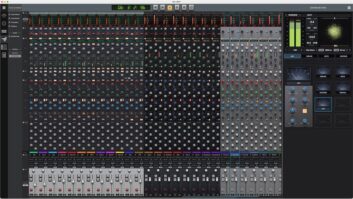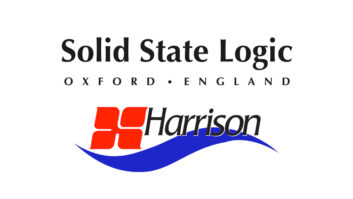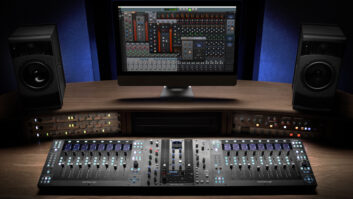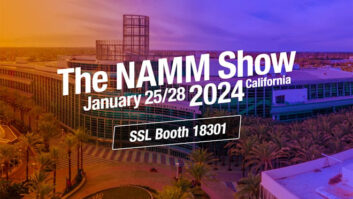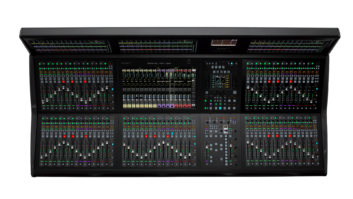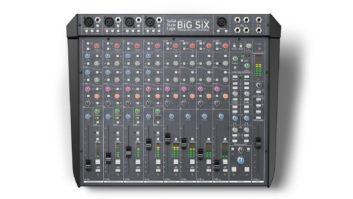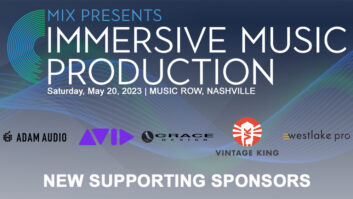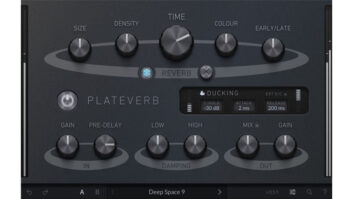There can be no denying that the transition to digital has proceeded at different speeds in different market segments. For the broadcast market, the appeal of control surface and routing flexibility has impressed a growing number of networks and call-letter stations. And in post, the ability to reset a complete console topology quickly and accurately means that a digital-capable facility can move sessions in and out of the room more efficiently. For music studios, however, there has been more reluctance, based on sonic performance and user familiarity.
Given Solid State Logic’s unarguable mastery in console design, and its conspicuous attention to ergonomics and user convenience, the new C200 Digital Production Console offers not only enhanced 24/96 performance with high-precision converters, but also makes fewer demands on the operator by mimicking the well-proven control surface layout from its analog predecessors.
Features
The new C200 and first cousin, the broadcast-specific C100, utilize new SSL magic: the proprietary Centuri processor that operates at a sampling rate of either 48 kHz or 96 kHz, and provides options for between 32 and 96 in-line signal paths, accommodating 12 programmable main outputs, 48 MTR (multitrack) buses, 96 direct outputs, 12 auxiliary busses and 12 stereo effects returns. And, unlike competitive designs, the Centuri retains all of its bussing and input/output capabilities at either sampling frequency. (The C200’s Centuri processing technology is also 192 kHz enabled.) In addition, the C200’s new engine provides enhanced operational benefits, including self-healing DSP, a feature that is said to have been designed specifically for live mixing.
The C200 console emulates the popular — and compact — in-line approach, with two banks of dedicated small and large faders providing simultaneous access to enhanced numbers of live, replay or mix sources. The in-line design provides two independent signal paths per processing channel: main Channel/large-fader and secondary Monitor/small-fader, each with dedicated input, output, motorized fader, cut, AFL/PFL/solo and multiformat pan. Three master status settings — Record, Replay and Mix — determine whether the large or small faders control Channel or Monitor paths, providing instant switching between tracking, overdub or all-input mix modes.
The typical C200 control surface comprises six eight-channel sections plus a dual-bucket control section, for a total of 48 dual-path (small and large fader) channels controlling 96 signal sources, with two layers per control path for a total of 96 simultaneous on-surface faders. The C200’s Channel Banking provides fast access to two layers of channels with global and individual channel A/B access buttons. For smaller control surface configurations, Virtual Bays provide additional layers; a console as compact as 16 channel strips may access all in-line DSP channels.
It’s a snap to use the C200’s Multiformat Mixing assignment to designate any of the 12 main busses as multiple 5.1 and/or stereo groups for conventional and/or stem-style mixing. Full-function 5.1 and stereo monitoring paths include insertion points for matrix encoders and decoders, as well as selection of external sources. The combination of fully-configurable, mono or stereo channel strips that operate at any physical position on the control surface means that the C200 provides an impressive amount of mono and/or stereo and/or 5.1 flexibility.
The C200’s design philosophy of dedicated “knobs-per-function” is particularly appropriate for mixing applications — including music production and live performance — where operators need to achieve simultaneous, instant access to a large numbers of controls. And the C200’s dedicated channel strips provide a familiar operational interface for both in-house and freelance engineers. It is great to have immediate access to everything you need, with a complete overview of all console settings — you just reach for the control and change it. Two innovative color-coded meter displays enable operators to view only large-fader or only small-fader signals as required, or all 96 large and small faders.
Front-to-back console dimension is dramatically less than conventional analog (and most digital) designs. Even the vertically challenged operator should be able to reach the most distant controls from a seated position; console rake is also shallower than on other SSL designs, further enhancing the C200’s ease of use. A special “mobile” configuration, with a custom developed center section, is available for multi-purpose studios or remote installations. Using a single-bay center section, up to 48 in-line C200 channel strips (105 faders) can be fitted across the width of a standard mobile.
In many ways, the new C200 incorporates all of the automation and recall benefits of SSL’s existing 9000 Series analog and MT Plus digital consoles, but with a host of new capabilities. These include scalable DSP and complete layer and signal-path metering, plus integrated DAW control (such as Digidesign Pro Tools HD; others to come) via a VGA display and USB interface option that enables audio editing functions from the center-section sweet spot using the C200’s keyboard plus pen/puck and tablet interface. The console’s automation offers off-line mix editing and on-line mix compare, plus other useful modes. And for broadcast production, the C200 incorporates redundant DSP capabilities, status lock and backstop PFL, plus third-party router integration that provides communications between an external router and the built-in digital router.
Compared to other control surface designs, which require the operator to remember where on several possible layers a targeted input or master buss may be assigned — and which can make system setup a shade complicated — the C200’s knob-per-function is a snap to master, yet doesn’t hamper the system’s undeniable versatility, while full scalability at either sampling rate enables large-format production.
In terms of signal processing, the C200 shines. All channels provide high and low-pass filters plus four-band parametric equalization profiles, including highly realistic digital equivalents of SSL E and G Series EQ emulation. Full dynamics control with independent compressor/limiter and gate/expander sections is also available on each signal path — a direct corollary of older analog E and G Series dynamics sections. SSL designers even included a digital emulation within the center-section compressor that offers the sonic performance of the popular G Series “Quad Bus” compressor. Because signal processing is dedicated to every channel there is no need to assign resources at the start of console setup.
The C200’s 12 aux busses can be configured as mono or stereo, and are fed from both fader paths with independent send levels from large/small faders. A nice touch: Aux balances can be set quickly using the Set Aux to LF or Aux Flip to Faders functions. Three directs are provided per channel strip, with post-fader channel and monitor paths, plus the pre-fader and pre/post-processing insert from channel or monitor path.
Connection to microphone sources is via fiber to separate C-SB stage boxes that can be located up to 1,500 feet (optionally 1 mile) from the processor core. A total of 48 remote-controlled mic sources occupy a single 14U chassis. Alternatively, SSL’s new C-SuperPre remote preamplifier is fitted with SuperPre analog circuits, analog inserts and high-speed 96 kHz NiTech A/D converters; it uses the same chassis and fiber system as the C-SB and provides 24 channels per 14U chassis. Elegant features include a low-level buffered output per channel (useful in live application for monitor-mixer feeds); over 90 dB of click-free gain; plus four DACs and GPIOs for communication and signaling. A fully loaded modular Centuri core provides up to a staggering 512 assignable inputs and outputs at 48 kHz (256 inputs/outputs at 96 kHz). I/O card options include analog, AES/EBU Digital and MADI, all at 24-bit with sample rate conversion. A 60-channel GPI card provides programmable machine starts, cue lights, and the rest.
In Use
In use, the C200 is a dream. Access to key controls is instant and obvious, and setups can be stored and recalled at the touch of a button. Bay Swapping enables remote sections to be brought to the sweet spot’s designated central master bay — or wherever you choose to work — while the center-section controls provide a minimum of clutter but a maximum of sensible, color-coded functionality. For C200 consoles with a reduced number of on-surface controls, a Virtual Bay feature provides additional layers thereby enabling a compact console with 16 channel strips to access all in-line channels. A choice of servo or VCA-style fader grouping is available; both large and small faders are motorized to provide moving-fader grouping. (And the familiar VCA-style fader grouping enables balance and adjustment of slave positions while a group master fader is adjusted.)
Summary
All in all, the SSL C200 Digital Production Console offers a great deal of sonic punch in a remarkably compact package. All front panel controls are well labeled and extremely easy to find; I predict that anybody reasonably familiar with an analog SSL console would be up and running on the C200 in a remarkably short period of time. The integration of workstation controls via USB ports is outstanding, and will ensure that mixing and editing functions can be performed from the sweet spot rather than off to one side. With 24/96 audio performance becoming de rigueur these days, the combination of hard disk workstation and C200 has a lot going for it. And with clients working on multiple projects at a time, facilities need a console that offers complete recall automation.
My thanks to the crew at Underdog Entertainment, Hollywood, co-owned by Harvey Mason Jr. and Damon Thomas, for kindly providing access to their new C200 Digital Production Console. The first music studio to install a C200, the console serves as the centerpiece of Underdog’s main recording and mix room.
Product Points
Applications: Studio, post production
Key features: Up to 96 channels; 24-bit, 96 kHz performance; four-band parametric EQ; Centuri processor; 5.1 surround sound
Price: starts under $300,000
Contact: Solid State Logic at 212-315-1111, Web Site.
